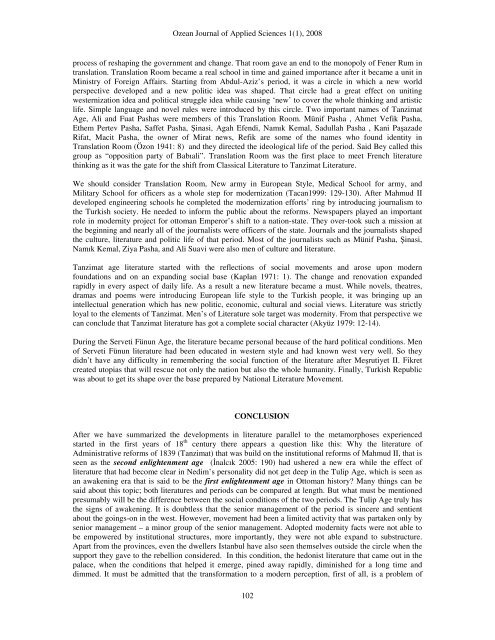Journal of Applied Science Studies - Ozean Publications
Journal of Applied Science Studies - Ozean Publications
Journal of Applied Science Studies - Ozean Publications
You also want an ePaper? Increase the reach of your titles
YUMPU automatically turns print PDFs into web optimized ePapers that Google loves.
<strong>Ozean</strong> <strong>Journal</strong> <strong>of</strong> <strong>Applied</strong> <strong>Science</strong>s 1(1), 2008<br />
process <strong>of</strong> reshaping the government and change. That room gave an end to the monopoly <strong>of</strong> Fener Rum in<br />
translation. Translation Room became a real school in time and gained importance after it became a unit in<br />
Ministry <strong>of</strong> Foreign Affairs. Starting from Abdul-Aziz’s period, it was a circle in which a new world<br />
perspective developed and a new politic idea was shaped. That circle had a great effect on uniting<br />
westernization idea and political struggle idea while causing ‘new’ to cover the whole thinking and artistic<br />
life. Simple language and novel rules were introduced by this circle. Two important names <strong>of</strong> Tanzimat<br />
Age, Ali and Fuat Pashas were members <strong>of</strong> this Translation Room. Münif Pasha , Ahmet Vefik Pasha,<br />
Ethem Pertev Pasha, Saffet Pasha, Şinasi, Agah Efendi, Namık Kemal, Sadullah Pasha , Kani Paşazade<br />
Rifat, Macit Pasha, the owner <strong>of</strong> Mirat news, Refik are some <strong>of</strong> the names who found identity in<br />
Translation Room (Özon 1941: 8) and they directed the ideological life <strong>of</strong> the period. Said Bey called this<br />
group as “opposition party <strong>of</strong> Babıali”. Translation Room was the first place to meet French literature<br />
thinking as it was the gate for the shift from Classical Literature to Tanzimat Literature.<br />
We should consider Translation Room, New army in European Style, Medical School for army, and<br />
Military School for <strong>of</strong>ficers as a whole step for modernization (Tacan1999: 129-130). After Mahmud II<br />
developed engineering schools he completed the modernization efforts’ ring by introducing journalism to<br />
the Turkish society. He needed to inform the public about the reforms. Newspapers played an important<br />
role in modernity project for ottoman Emperor’s shift to a nation-state. They over-took such a mission at<br />
the beginning and nearly all <strong>of</strong> the journalists were <strong>of</strong>ficers <strong>of</strong> the state. <strong>Journal</strong>s and the journalists shaped<br />
the culture, literature and politic life <strong>of</strong> that period. Most <strong>of</strong> the journalists such as Münif Pasha, Şinasi,<br />
Namık Kemal, Ziya Pasha, and Ali Suavi were also men <strong>of</strong> culture and literature.<br />
Tanzimat age literature started with the reflections <strong>of</strong> social movements and arose upon modern<br />
foundations and on an expanding social base (Kaplan 1971: 1). The change and renovation expanded<br />
rapidly in every aspect <strong>of</strong> daily life. As a result a new literature became a must. While novels, theatres,<br />
dramas and poems were introducing European life style to the Turkish people, it was bringing up an<br />
intellectual generation which has new politic, economic, cultural and social views. Literature was strictly<br />
loyal to the elements <strong>of</strong> Tanzimat. Men’s <strong>of</strong> Literature sole target was modernity. From that perspective we<br />
can conclude that Tanzimat literature has got a complete social character (Akyüz 1979: 12-14).<br />
During the Serveti Fünun Age, the literature became personal because <strong>of</strong> the hard political conditions. Men<br />
<strong>of</strong> Serveti Fünun literature had been educated in western style and had known west very well. So they<br />
didn’t have any difficulty in remembering the social function <strong>of</strong> the literature after Meşrutiyet II. Fikret<br />
created utopias that will rescue not only the nation but also the whole humanity. Finally, Turkish Republic<br />
was about to get its shape over the base prepared by National Literature Movement.<br />
CONCLUSION<br />
After we have summarized the developments in literature parallel to the metamorphoses experienced<br />
started in the first years <strong>of</strong> 18 th century there appears a question like this: Why the literature <strong>of</strong><br />
Administrative reforms <strong>of</strong> 1839 (Tanzimat) that was build on the institutional reforms <strong>of</strong> Mahmud II, that is<br />
seen as the second enlightenment age (İnalcık 2005: 190) had ushered a new era while the effect <strong>of</strong><br />
literature that had become clear in Nedim’s personality did not get deep in the Tulip Age, which is seen as<br />
an awakening era that is said to be the first enlightenment age in Ottoman history Many things can be<br />
said about this topic; both literatures and periods can be compared at length. But what must be mentioned<br />
presumably will be the difference between the social conditions <strong>of</strong> the two periods. The Tulip Age truly has<br />
the signs <strong>of</strong> awakening. It is doubtless that the senior management <strong>of</strong> the period is sincere and sentient<br />
about the goings-on in the west. However, movement had been a limited activity that was partaken only by<br />
senior management – a minor group <strong>of</strong> the senior management. Adopted modernity facts were not able to<br />
be empowered by institutional structures, more importantly, they were not able expand to substructure.<br />
Apart from the provinces, even the dwellers Istanbul have also seen themselves outside the circle when the<br />
support they gave to the rebellion considered. In this condition, the hedonist literature that came out in the<br />
palace, when the conditions that helped it emerge, pined away rapidly, diminished for a long time and<br />
dimmed. It must be admitted that the transformation to a modern perception, first <strong>of</strong> all, is a problem <strong>of</strong><br />
102

















